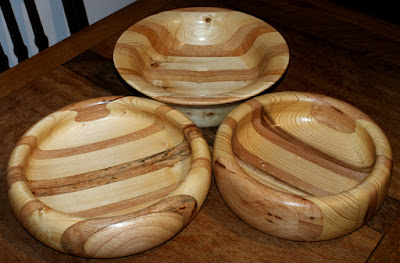In our continuing quest to recycle and re-purpose things we get from free cycling and other places I have used some tiles we recently came across to make a couple of trivets or pot stands for putting hot saucepans on, although they could be used for other things, like maybe putting house plants on.
The tiles are solid marble and as well as being quite heavy they are quite large (20 cm square) so they are pretty good for this kind of thing.
Here's one of the tiles -
 |
| Not bad we got 10 in all. |
People have made tiles into pot stands and such like for ages, so this isn't a new thing, but it's a good use of any left over tiles you might have.
All you need to do is make a simple wooden frame, although with these tiles I could have just stuck some rubber pads on the bottom and they would have done just as well, but having a frame makes them look a little nicer.
The frame is made from tile batten (I could probably write a book with 101 uses for tile batten) it's a simple mitred frame, all I've done is put rebate in the wood so the tile sits inside the frame, but still stands proud of the wood so that when a pan is put on it only the tile comes into contact with the bottom of the pan.
Tile batten ready for routing -
 |
| Probably not the best way to hold wood for this type of job. |
Using my router I made a rebate in the entire length of wood, then I cut four pieces with a 45 degree angle at each end.
One piece cut, just need another three -
 |
| You can see the rebate where the tile will sit. |
All four bits cut -
 |
| I used a mitre saw for the angles. |
To fix it all together I used wood glue and a frame clamp, I've also glued the tile into the frame so it won't slip out.
Glued and clamped -
 |
| Just waiting for the glue to set. |
It was at this point I though that putting some small foam / rubber pads on the bottom would be a good idea, it helps to stop the trivet moving about, and it also raises it up a bit so that if it's moved about it won't scratch the work top, the problem was I didn't actually have any foam / rubber pads, so I made some from a piece of neoprene.
This is pretty easy, all you need is a bit of foam, and a way to cut small circles out of it, you could use scissors but with thick foam this might be difficult and there's an easier way, all you need is a small bit of tube, steel is better, make sure it's diameter is about the right size for what you need, the bit I used is about 10mm and this works on various materials.
What you need to do is sharpen the end of the tube, this is easy if you have a belt sander or a bench top sander like me, you can also do it with files, but it'll take a bit longer, you need to make a cutting edge at the very end of the tube by grinding / sanding the end of the tube at an angle.
Here's my foam cutter -
 |
| It's actually quite sharp. |
You can see the angle on the end of the tube, you can also run a small file or a bit of sand paper around the inside of the tube to improve the cutting edge, then all you need to do is place your newly made cutter onto the foam and twist as you push down, if you get it nice and sharp you don't need to put much pressure on it, although thicker materials will need more force.
Putting it to practice -
 |
| It works surprisingly well. |
I made a few cuts whilst getting the cutting edge nice and sharp, the end result is easy to make foam pads with a nice clean edge.
Like so -
 |
| I've already used it again to make some new pads for a laptop. |
If you use some double sided tape on the foam you can make your own sticky pads for what ever you might need them for, as the caption says I recently made some new foam pads / feet for a laptop out of some slightly thicker stuff.
Back to the trivets, once the glue had dried I gave the wood a bit of a sand and then stained and waxed it, I've gone for a dark stain, but you could use any colour you like, or just leave the wood in it's natural colour, I used a hard wearing clear wax to seal the wood, but a clear varnish would do just as well, it means the trivet can be wiped clean easily, once that was done I stuck the foam pads onto the wood and that's about it.
It's not a new idea, but it's a good use of some old tiles, and they make useful things and pretty good presents for people, and they cost next to nothing to make, the wood worked out at about £1.50 and I made two trivets and had some wood left over, you can use any sized tile you like, small ones make good coasters.
Small blue tile, just about the right size for a cup -
 |
| Made in the same way. |
Two finished trivets -
 |
| I know it looks like a crack, but it's just the way the marble is, honest. |
Thanks for reading.









































